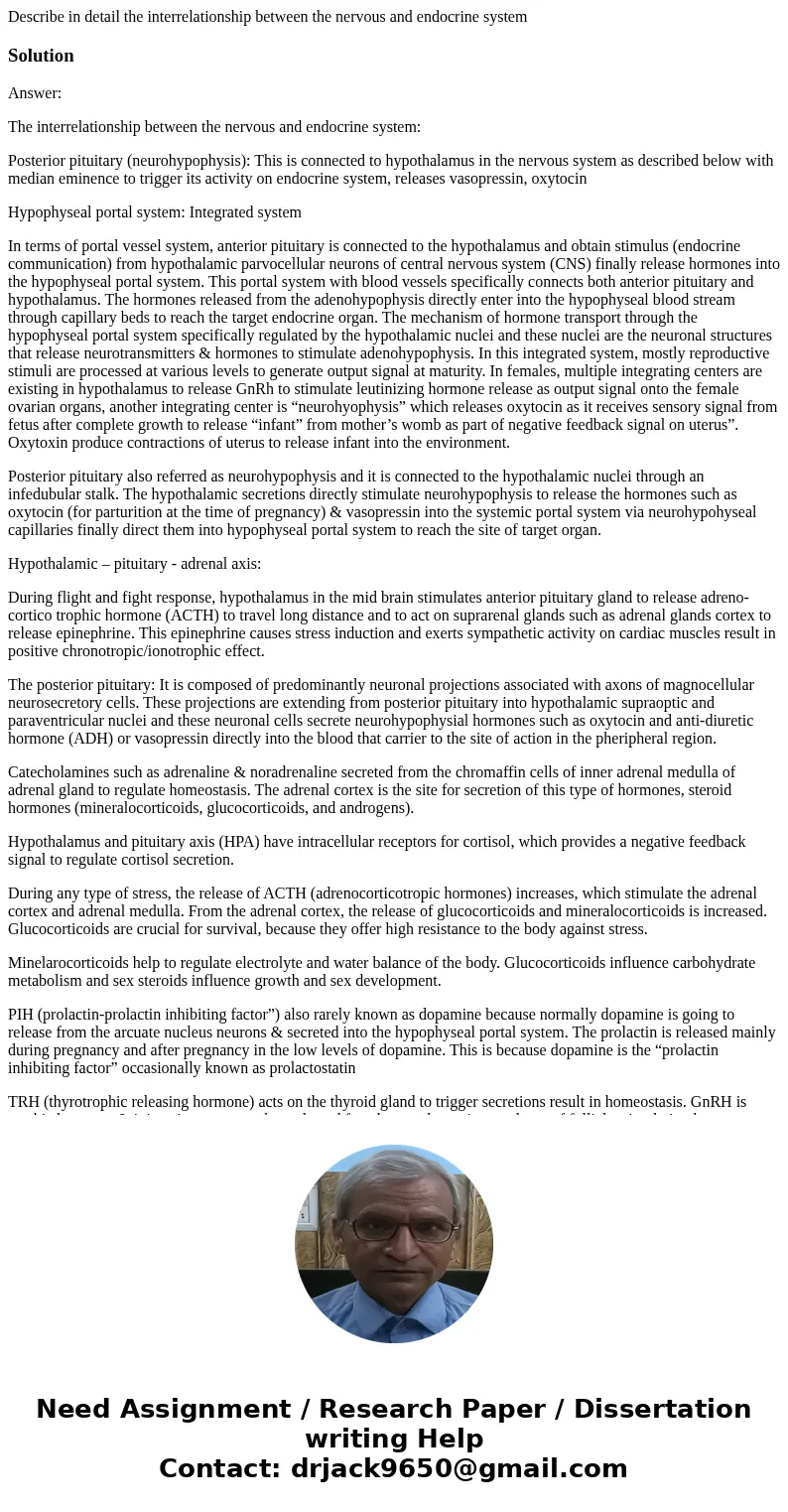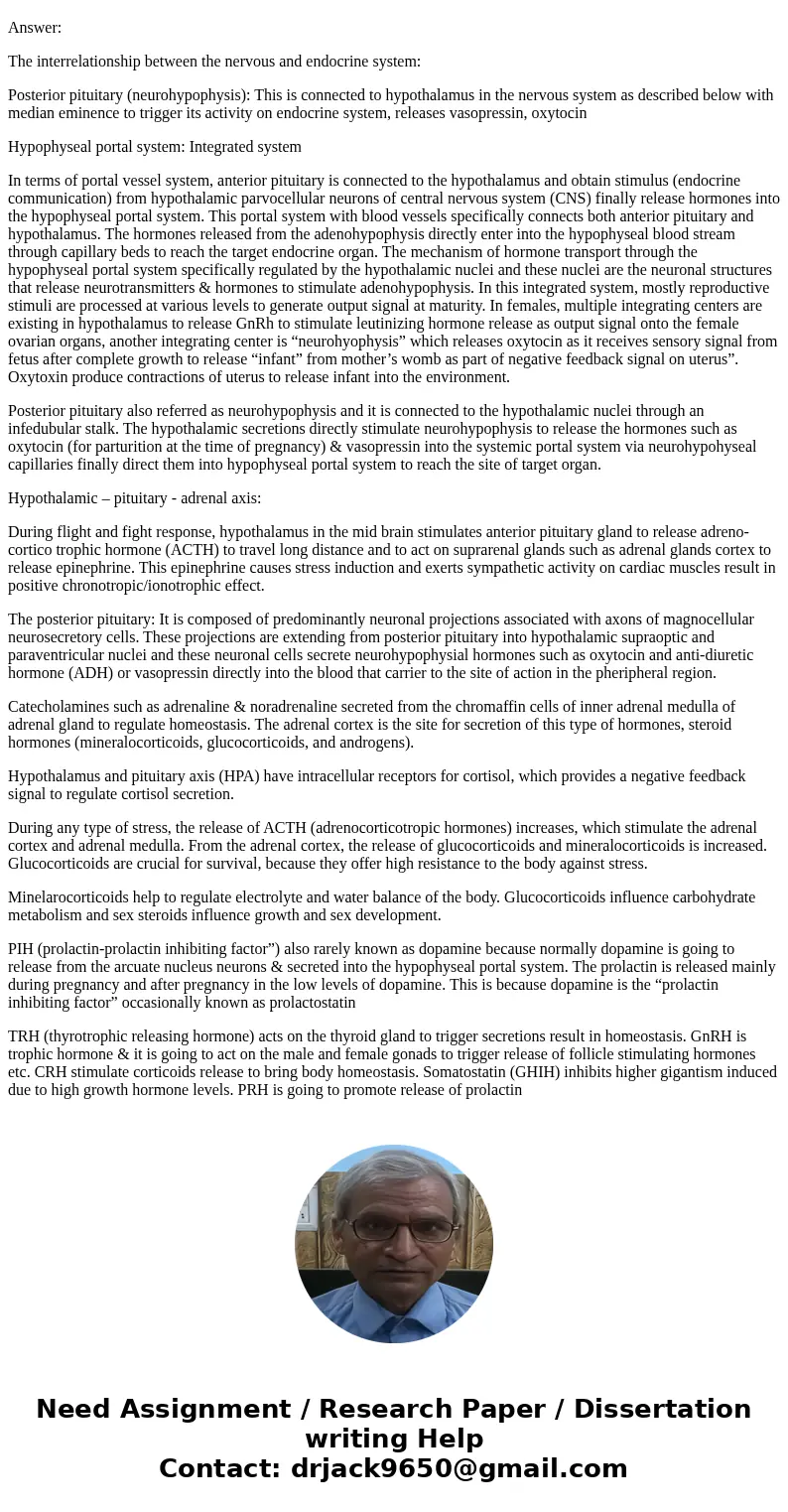Describe in detail the interrelationship between the nervous
Describe in detail the interrelationship between the nervous and endocrine system
Solution
Answer:
The interrelationship between the nervous and endocrine system:
Posterior pituitary (neurohypophysis): This is connected to hypothalamus in the nervous system as described below with median eminence to trigger its activity on endocrine system, releases vasopressin, oxytocin
Hypophyseal portal system: Integrated system
In terms of portal vessel system, anterior pituitary is connected to the hypothalamus and obtain stimulus (endocrine communication) from hypothalamic parvocellular neurons of central nervous system (CNS) finally release hormones into the hypophyseal portal system. This portal system with blood vessels specifically connects both anterior pituitary and hypothalamus. The hormones released from the adenohypophysis directly enter into the hypophyseal blood stream through capillary beds to reach the target endocrine organ. The mechanism of hormone transport through the hypophyseal portal system specifically regulated by the hypothalamic nuclei and these nuclei are the neuronal structures that release neurotransmitters & hormones to stimulate adenohypophysis. In this integrated system, mostly reproductive stimuli are processed at various levels to generate output signal at maturity. In females, multiple integrating centers are existing in hypothalamus to release GnRh to stimulate leutinizing hormone release as output signal onto the female ovarian organs, another integrating center is “neurohyophysis” which releases oxytocin as it receives sensory signal from fetus after complete growth to release “infant” from mother’s womb as part of negative feedback signal on uterus”. Oxytoxin produce contractions of uterus to release infant into the environment.
Posterior pituitary also referred as neurohypophysis and it is connected to the hypothalamic nuclei through an infedubular stalk. The hypothalamic secretions directly stimulate neurohypophysis to release the hormones such as oxytocin (for parturition at the time of pregnancy) & vasopressin into the systemic portal system via neurohypohyseal capillaries finally direct them into hypophyseal portal system to reach the site of target organ.
Hypothalamic – pituitary - adrenal axis:
During flight and fight response, hypothalamus in the mid brain stimulates anterior pituitary gland to release adreno- cortico trophic hormone (ACTH) to travel long distance and to act on suprarenal glands such as adrenal glands cortex to release epinephrine. This epinephrine causes stress induction and exerts sympathetic activity on cardiac muscles result in positive chronotropic/ionotrophic effect.
The posterior pituitary: It is composed of predominantly neuronal projections associated with axons of magnocellular neurosecretory cells. These projections are extending from posterior pituitary into hypothalamic supraoptic and paraventricular nuclei and these neuronal cells secrete neurohypophysial hormones such as oxytocin and anti-diuretic hormone (ADH) or vasopressin directly into the blood that carrier to the site of action in the pheripheral region.
Catecholamines such as adrenaline & noradrenaline secreted from the chromaffin cells of inner adrenal medulla of adrenal gland to regulate homeostasis. The adrenal cortex is the site for secretion of this type of hormones, steroid hormones (mineralocorticoids, glucocorticoids, and androgens).
Hypothalamus and pituitary axis (HPA) have intracellular receptors for cortisol, which provides a negative feedback signal to regulate cortisol secretion.
During any type of stress, the release of ACTH (adrenocorticotropic hormones) increases, which stimulate the adrenal cortex and adrenal medulla. From the adrenal cortex, the release of glucocorticoids and mineralocorticoids is increased. Glucocorticoids are crucial for survival, because they offer high resistance to the body against stress.
Minelarocorticoids help to regulate electrolyte and water balance of the body. Glucocorticoids influence carbohydrate metabolism and sex steroids influence growth and sex development.
PIH (prolactin-prolactin inhibiting factor”) also rarely known as dopamine because normally dopamine is going to release from the arcuate nucleus neurons & secreted into the hypophyseal portal system. The prolactin is released mainly during pregnancy and after pregnancy in the low levels of dopamine. This is because dopamine is the “prolactin inhibiting factor” occasionally known as prolactostatin
TRH (thyrotrophic releasing hormone) acts on the thyroid gland to trigger secretions result in homeostasis. GnRH is trophic hormone & it is going to act on the male and female gonads to trigger release of follicle stimulating hormones etc. CRH stimulate corticoids release to bring body homeostasis. Somatostatin (GHIH) inhibits higher gigantism induced due to high growth hormone levels. PRH is going to promote release of prolactin


 Homework Sourse
Homework Sourse